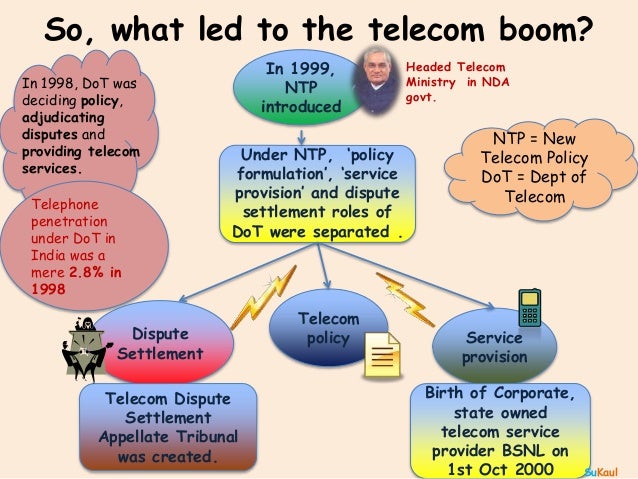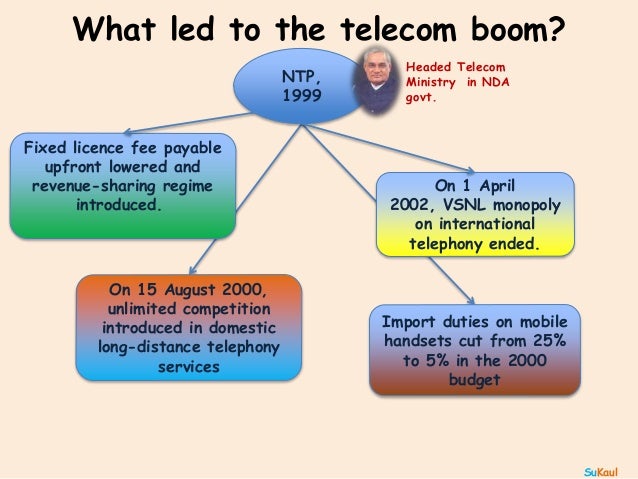The rapid
growth of mobile telephony in India ranks inarguably as one of India’s greatest
success stories. Cheap telephone connectivity has empowered individuals in
myriad ways, and has served as a massive productivity multiplier for the
economy by collapsing communication costs.
It is
important to trace the history of telephony and draw lessons from this success
story, for such successes have been rare in our history
There are two facts about the telecom boom that
are obvious but merit repetition—
- first, the growth was driven by the private sector,
not state-owned companies or the government; and
- second, the boom has been brought about by the rapid
uptake of mobile telephony, not landline telephones or public call office
(PCO) booths.
How NTP - 1999 was a game changer ?
The New Telecom Policy
(NTP) announced by the government of India on 3 March 1999 recounted some facts
about the status of the telecom sector in India at the time. It noted that
India had “over 1 million” mobile phone subscribers. Ten years after Rajiv
Gandhi’s government left office in 1989 and eight years after Pitroda returned
to the US, following Rajiv Gandhi’s assassination, tele-density moved from 0.6%
in 1989 to 2.8% in 1999
Does that
constitute a “revolution” and does that make Rajiv Gandhi and Sam Pitroda the
progenitors of the mobile revolution?
- Recent data says that India had over 700 million active mobile phone connections as of October 2012, catapulting the telecom penetration rate from less than 3% in 1999 to over 70% as of October 2012 and fast closing in on developed world standards.
- The 1999 NTP has far exceeded its own target of
achieving 15% tele-density by 2010, which would have probably sounded
overly optimistic when announced in 1999. How did this massive growth
happen? Does any specific individual or policy deserve more credit than
others?
Speaking at a corporate
awards function in December 2009 where his company was felicitated, Idea
Cellular’s then managing director Sanjeev Aga was asked to identify what in his
view marked the turning point for India’s telecom sector. Aga pointed to the
1999 NTP, saying: “When I read it today, it is still contemporary and
comprehensive.” Aga characterized the NTP as a “watershed event”
In his book, India—The Emerging Giant, Columbia
University’s Professor Arvind Panagariya also addresses the question of what
catalysed growth in telecom.
- Panagariya writes that key policy reforms were implemented by the Atal Bihari Vajpayee government in 1999, with one of the most important measures being separation between policy formulation and service provision, culminating with the birth of Bharat Sanchar Nigam Ltd (BSNL) on 1 October 2000.
- Getting rid of this very obvious conflict of interest
freed the telecom sector from political control. Vajpayee, who also held
the telecom portfolio at the time, took the politically difficult step of
corporatizing BSNL, and Panagariya writes that the prime minister
personally intervened to push through this deep structural reform.
The creation of BSNL
- The creation of BSNL wasn’t easy—Panagariya writes that 400,000
department of telecommunications (DoT) employees went on a long strike to
oppose it. Though the Vajpayee government conceded almost all their
demands, there was no going back on the fundamental principle of
separating policy formulation from service provision and the accompanying
corporatization
- Besides this step, the 1999 NTP separated the DoT’s regulatory and dispute settlement roles too, with the creation of the Telecom Dispute Settlement Appellate Tribunal.
- Before these reforms, the DoT was deciding policy for
the sector, adjudicating disputes and providing telecom services. That
such glaring conflicts of interest persisted for so many decades reflects
on the calibre and intent of the governments that preceded the Vajpayee
administration.
- Under the 1999 NTP, the fixed licence fee payable upfront
was lowered with the government introducing a revenue-sharing regime.
The media was very hostile
to the new policy. Frontline magazine ran a stinging critique of the policy,
holding former prime minister Vajpayee guilty of “a new standard of
impropriety”. Outlook magazine said that Vajpayee’s moves “had all the
trappings of a financial scam”

- On 15 August 2000, “unlimited competition” was
introduced in domestic long-distance telephony services.
- Just as importantly, import duties on mobile handsets
were cut from 25% to 5% in the 2000 budget delivered by Yashwant
Sinha.
- On 1 April 2002, Videsh Sanchar Nigam Ltd’s monopoly
on international telephony ended.

Panagariya documents all
these changes painstakingly in his book, and it is these changes that deserve
credit for the rapid increase in tele-density over the last decade
- Pitroda, in fact, torpedoed attempts to bring mobile telephony to India in 1987, as Panagariya records.
- DoT had received World Bank funding to deploy a
cellular network in Bombay (as the city was then called), with Sweden’s
Ericsson winning the project.
- Panagariya writes that Pitroda, who was heading the
Centre for Development of Telematics (CDoT), created at his behest by
Indira Gandhi in August 1984, went to the media arguing that “luxury car
phones” were “obscene” in a nation where “people were starving”.
Pitroda’s intervention
escalated the issue to Rajiv Gandhi, who pulled the plug on what would have
probably been India’s first cellular network deployment. Panagariya cites this
case as an example of how turf wars within government arise in response to
policy changes: because Pitroda felt that mobile telephony threatened his work
at CDoT, he did not hesitate to use his influence to stop what may have been a
better way to achieve the outcome of increasing tele-density
As the data bears out, Pitroda’s strategy to
grow tele-density through indigenous development in CDoT failed conclusively.
Pitroda did not return to India till 2004, when the Congress party formed the
Union government once again.
The results speak for themselves: Rajiv Gandhi and
Pitroda’s model of promoting indigenous technology with the DoT trying to meet
demand for telephones did not succeed, whereas the Vajpayee government’s
policies curtailed the state’s role and created space for private entrepreneurs
to deliver cheap and reliable telecom service speedily on a massive scale.
The former tried to grow by state-led indigenization, the latter threw open the sector to competition and entrepreneurship.
India’s telecom story is a
shining testament to how policy clarity, political conviction for reforms and
private entrepreneurship can deliver outcomes, within a decade, that government
intervention and well-intentioned bureaucratic thinking cannot even conceive
of. The lesson from India’s telecom boom is that curtailing government control
and public-sector clout in sectors such as agriculture, mining, defence, power,
ports and banking can deliver similar outcomes—and no amount of spin doctoring
by any individual or political party should be allowed to detract from this
lesson.

